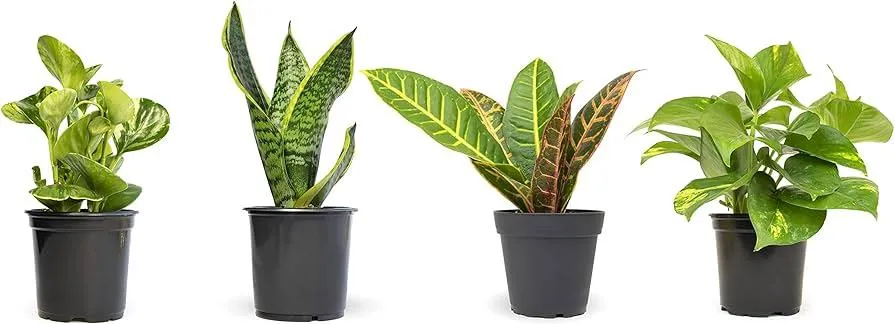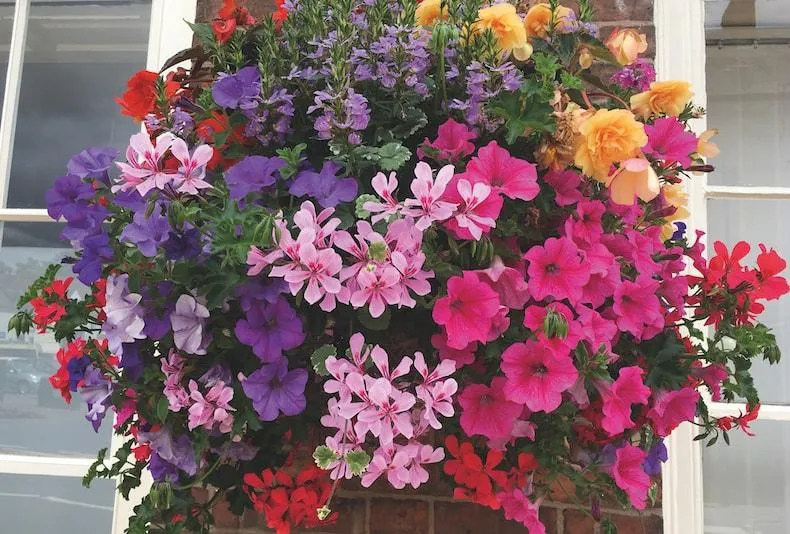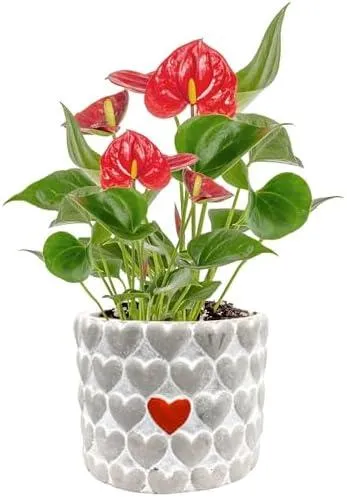The Top 10 Plants for Beautiful Hanging Baskets
Growing plants in hanging baskets is a great way to add some green flair to your indoor or outdoor space. Whether you have a patio, balcony or want to liven up a room inside, hanging baskets provide an easy and visually appealing option for displaying flowering or foliar plants. As someone who has dabbled with my fair share of hanging planters over the years, let me share my top 10 picks for the best indoor hanging basket plants.
1. Petunias
- Petunias are a no-brainer choice that basically every plant enthusiast seems to gravitate towards. And for good reason – they come in an amazing array of colors and bloom profusely throughout the summer. I swear, I once had a bunch of pink petunias that were just stunning. They filled the whole basket with these ruffly blooms. You can’t go wrong with classics like that.
- Petunias thrive in full sun and require regular watering to keep them perky. They come back year after year too, which is nice if you don’t want to restart a hanging planter from scratch each season. Just trim off any dead flowers to encourage more blooms.
2. Fuchsias
Fuchsias are another top performer, with their vibrantly colored dangling flowers. I kind of think of them as the petunias’ more extravagant cousin. The blooms come in shades of red, pink, purple and white. From my experience, fuchsias prefer partial shade instead of baking in full sun all day. Be sure to water them regularly while they’re actively flowering. Deadheading spent blooms helps sustain growth.
3. Geraniums
Geraniums offer a nice pop of color with their round, clustered blooms. Sort of like little puffy balls decorating the foliage. They come in every color under the rainbow – so you have lots of options for incorporating them into your planter palette. Geraniums can tolerate a range of light conditions, from full sun to partial shade. They’re pretty tough plants overall. Just reduce watering a bit in cooler months when growth slows.
4. Begonias
Begonias add lush greenery with pretty crimson, pink or white blossoms peeking through. The tropical-looking foliage is seriously amazing, in my humble opinion. These begonias prefer moderate indirect sunlight and consistent moisture. Too much direct sun might scorch their leaves. Be sure to trim spent flowers frequently to encourage continued blooming throughout the growing period.
5. Impatiens
Impatiens flowers pack a punch with their bright, jewel-tone colors. You can find them in shades of red, orange, pink, purple and white. Their succulent-like leaves and prolific blooms make for a quick and full basket. Impatiens thrive best in shade or partial shade with adequate moisture. I’ve seen some funky rainbow combos with different impatiens varieties that were quite rad.
6. Bacopa
For trailing foliage, bacopa is a stellar option. The petite purple or white flowers add a pinpoint of color against its mounds of green leaves. This is a nice one to combine with more showy bloomers. Bacopa loves humidity and requires consistent moisture levels to keep its leave looking lush and healthy. It can handle varying degrees of shade.

7. Verbena
Verbena is another flowering plant that just keeps on giving all season. The clusters of tiny blooms emerge in bright shades of pink, purple, scarlet and white. Verbena is pretty hardy and heat tolerant once established. However, too much sun might cause leaf scorching. It prefers richer, well-draining soil that’s regularly watered but not soggy. Deadheading ensures continued flowering.
8. Ivy
No plant list would be complete without a trailing ivy option. English ivy orSwedish ivy work great in hanging planters, spilling gracefully over the edges with their lush foliage. While they don’t flower, the green or variegated leaves add lovely visual texture. Ivy thrives best with moderate light and occasional watering to prevent wilting. It can take drought conditions once accustomed to its spot.
9. Pheasant’s Eye
This vivid blue-flowering plant has always kinda impressed me, to be honest. Its little round blooms really pop against the ferny gray-green foliage. Pheasant’s eye brightens up any shady spot, spreading gradually via rhizomes or stolons. Water as needed to prevent drying out, taking care not to soak the crown. Cut back after flowering to promote reblooming.
10. Violet
For a unique purple-hued option, violets are a solid choice. The bracts emerge in shades of violet, lavender, pink and white over mounds of heart-shaped leaves. I think their faces are just the cutest. Violets prefer partial shade with constant moisture to thrive. They grow best in fertile, organic potting mixes. Snip off spent flowers as they fade to encourage reblooming.
So in summary, those are some top plant ideas to fill your indoor or patio hanging baskets with pizzazz. As you can see, some flowers require more TLC than others – but it’s all rewarding to watch them flourish. Once you settle on your basket combo, be sure to give them the proper light, water and pruning they need for continued beauty. Here are some additional tips when caring for hanging baskets:
Fertilize regularly during the growing season – This helps supply key nutrients for healthy growth. I like to use a balanced liquid plant food mixed at half the recommended strength every other week or so.

Repot annually in spring – Hanging baskets tend to become rootbound faster than container plants. Shake out the old soil and refresh for a bountiful new season.
Rotate baskets weekly – This encourages even growth by exposing all sides to light equally. It’s easy to forget which I admit.
Use water-absorbing polymers – Products like water crystals hold moisture at the root zone longer between waterings. Less drying out = less wilting drama for you to deal with. Win-win!
Anchor securely – Ensure baskets won’t topple over from heavy rains or strong breezes. Hanging cables or hardware cloth under the soil adds stability. Don’t want any plant casualties on your watch!
Does this help give you a clear picture of the top plant picks and care instructions for achieving picture-perfect indoor hanging planters? Let me know if you have any other questions! I’d be curious to hear about what combo you settle on to liven up your space. Cheers and happy gardening!
Top Plants for Hanging Baskets
| Plant | Care Level | Size | Bloom Color |
|---|---|---|---|
| ivy | Low | Medium | Green |
| English ivy | Low | Large | Green |
| Pothos | Low | Medium | Variegated green and white |
| Begonia | Medium | Medium | Red, pink, orange |
| Million bells | Low | Small | Pink |
FAQ
-
What are some good hanging basket plants for indoors?
Some top choices for indoor hanging baskets include tradescantia, pothos, english ivy, and purple waffle plant. Tradescantia comes in lots of cool colors and can tolerate low light. Pothos is nearly impossible to kill – it does awesome in low light and doesn’t need consistent watering. English ivy looks gorgeous hanging and trailing over the edges of a basket. The purple waffle plant has really interesting textures and patterns on its leaves.

-
Do all plants do well hanging in a basket?
Not all plants dig being in a hanging basket. Some rather stay rooted in the soil. At the same time, plants with long, trailing vines and those that like to spill over the edges suit hanging planters. Those with compact rosettes or upright forms kinda seem awkward and may not thrive as much. You gotta pick plants built for the lifestyle, man. Know what I mean?
-
What types of baskets are good for plants?
When it comes to baskets, fabric or wicker work pretty solid. They allow water and air to get through to the soil. Plastic baskets can suffocate roots if they don’t have drainage holes. Metal and ceramic planters also need holes or they’ll drown your greenery, dude! Additionally, consider material, size, and color. Will your basket choice complement your decor? Will your plants fit and have enough space to flourish? Think it through, homie!
-
How often should I water hanging baskets?
Checking soil moisture and watering when the top inch is dry is always a good call. Unlike pots on the ground, hanging baskets dry out quicker due to exposure. In warm weather, water every few days. In air conditioning, once weekly could work. However, depending on plant type and conditions, needs may differ. Pay attention and use your gut, amigo! Better to water lightly more often than soak everything and hope for the best.
-
What’s the best way to control pests on hanging plants?
Prevent bugs from the jump by picking pest-proof plants whenever possible. Check welts carefully before bringing anything indoors. At the slightest sign of an infestation, quarantine the basket ASAP. Then examine plants top and bottom for pests, eggs, and damage. Basic rubbing alcohol or neem oil usually does the trick if you stay on top of it. But persistent problems might require stronger methods. Best not to let issues get too crazy in the first place, eh?
-
How long will a hanging basket last?
If well cared for, an indoor hanging basket can hang in there for months. But many factors play roles in its lifespan. Amount of light, water, fertilizer, and pests affect how long it will look its best. Out of sight plants tend to last shorter times. Resist the temptation to keep something once it’s faded. Replace as needed to keep things looking fresh! A hanging planter is a commitment, amigos, but totally worthwhile.
-
What’s the best way to display multiple hanging baskets?
For a really snazzy look, try grouping baskets of similar sizes together from the ceiling. You can also hang individual planters from wall hooks or rails at varying heights. Make sure the space feels balanced. Another cool thing is placing baskets atop shelving, sideboards, or on open beams. Be creative and go for an eclectic, artsy vibe. But mostly just find a manner that shows plants off to their best advantage!

